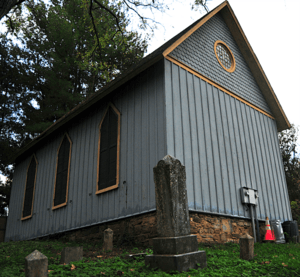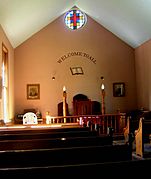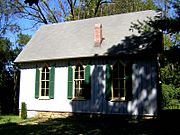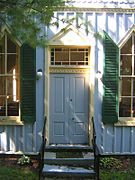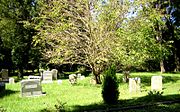St. John's Church (Ruxton, Maryland) facts for kids
Quick facts for kids |
|
|
St. John's Church
|
|

A view of the church from the north side.
|
|
| Location | 7538 Bellona Ave., Ruxton, Maryland |
|---|---|
| Area | 0.8 acres (0.32 ha) |
| Built | 1886 |
| Built by | Horn, George |
| Architectural style | Gothic |
| NRHP reference No. | 82002807 |
| Added to NRHP | March 15, 1982 |
St. John's Church is a historic church in Ruxton, Maryland. It was built by an African-American community in the late 1800s. The church is part of the African Union Methodist Protestant (A.U.M.P.) denomination. It is recognized as a special landmark because of its history and unique design.
Contents
History of the Church
A New Community
The story of St. John's Church begins in the 1820s with a man named J. Aquila Scott. He was a free African-American who moved to an area called Bare Hills. At that time, the local African-American congregation held church meetings in his home.
In 1833, Scott and four other leaders bought land to build a proper church and a cemetery. The first church they built was a simple log cabin. This cabin became the heart of their community for many years.
Fire and Rebuilding
Sadly, the original log church burned down in 1876. But the community did not give up. Ten years later, in 1886, a new church was built on the same spot. This new building was led by Reverend Edward W. Scott, who was J. Aquila Scott's son. This is the beautiful church that still stands today.
For a long time, the church was a vital center for the local African-American community. It served people living in Bare Hills and those who worked in the nearby town of Ruxton.
Architecture and Design
St. John's Church is a special example of the Carpenter Gothic style. This style uses wood to create designs that look like the fancy stone cathedrals of Europe. The church has a steep, pointed roof and siding made of vertical wooden planks called board-and-batten. It also has tall, narrow windows known as lancet windows.
Because of its unique design, the church is considered an amazing example of a church built by an African-American community in the 19th century.
Also on the property is a stone house that was used as a parsonage (a home for the church's minister). There is also a social hall and a large burial ground behind the church.
Rediscovery and Restoration
By the 1960s, fewer people were attending the church. It was eventually closed and almost forgotten.
Then, in 1980, a local resident named Gail B. O'Donovan found the old chapel. She learned about its important history and wanted to save it. She helped bring the community together to raise $108,000. This money was used to restore the church and the old stone parsonage, which had been damaged by a fire.
Thanks to these efforts, St. John's Church was saved. It was added to the National Register of Historic Places on March 15, 1982. This listing helps protect the church for future generations to appreciate.
Gallery
References




